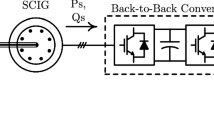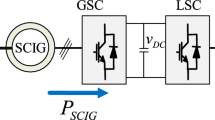Abstract
Designing a control system that is robust against changes in the steady state operating point as well as transient states of the system, especially in the presence of constant power loads, is one of the most important issues in the isolated operation mode of wind energy conversion systems (WECS). In this paper, a robust control structure is proposed for a squirrel cage induction generator-based WECS feeding isolated loads, including constant power loads. The proposed control structure includes two controllers, a flux control system for the machine side converter and a voltage control system for the load side converter. The proposed flux controller is designed based on the adaptive input–output feedback linearization method, and in a new reference frame whose rotation speed at each instant of time is extracted by a cascaded DC voltage regulator based on the fractional order PI method. This regulator maintains the DC-link voltage of the back-to-back converters in the nominal range by controlling the output power of the generator through the speed regulation of the proposed reference frame. The proposed voltage control system includes a voltage regulator based on the adaptive backstepping control method. The proposed controller robustly forces the load voltage magnitude to maintain within its nominal value. The proposed control system is shown to be strong and stable against the presence of constant power load, uncertainties and disturbances. The validity and effectiveness of proposed control structure are demonstrated through simulation studies in the MATLAB® software environment.





Similar content being viewed by others
Data availability
The datasets generated during and/or analysed during the current study are available from the corresponding author on reasonable request.
Abbreviations
- CPL:
-
Constant power load
- LSC:
-
Load sile converter
- IOFL:
-
Input-output feedback linearization
- MSC:
-
Machine side converter
- SCIG:
-
Squirrel-cage induction generator
- WECS:
-
Wind energy conversion system
- \({{\omega }_{r}}\) :
-
Rotor shaft mechanical speed
- \({{\omega }_{e}}, {{\omega }_{ev}}\) :
-
Rotational speed of synchronous dq and xy reference frames
- \({{\theta }_{e}}, {{\theta }_{ev}}\) :
-
Angular position of synchronous dq and xy reference frames
- \({T}_{m}, {T}_{e}\) :
-
Mechanical, electromagnetic torques
- \({P}_{s}, {Q}_{s}\) :
-
Stator active and reactive power
- \({P}_{g}, {Q}_{g}\) :
-
Grid active and reactive power
- \({V}_{dc}, {I}_{dc}\) :
-
DC-link voltage and current
- J :
-
Lumped inertia momentum
- D :
-
Lumped damping factor
- \({{R}_{s}}, {{R}_{r}}\) :
-
Stator, rotor resistances
- \({{L}_{s}}, {{L}_{r}}\) :
-
Stator, rotor inductances
- \({{L}_{m}}\) :
-
Magnetizing inductance
- \({{\sigma }}\) :
-
Leakage factor
- P :
-
Pole numbers
- \({{\lambda }_{sdq}}, {{\lambda }_{sxy}}\) :
-
Stator flux linkage in dq and xy frames
- \({{I}_{sdq}}, {{I}_{sxy}}\) :
-
Stator current in dq and xy frames
- \({{V}_{sdq}}, {{V}_{sxy}}\) :
-
Stator voltage in dq and xy frames
- \({{V}_{idq}}, {{V}_{ixy}}\) :
-
Inverter voltage in dq and xy frames
- \({{V}_{fdq}}, {{I}_{fdq}}\) :
-
LSC voltage and current in dq frames
- \({{W_{v,i,\lambda }}}\) :
-
Lyapunov functions
- \({{\hat{R}}_{s}}\) :
-
Estimated stator resistance
- \({{\tilde{R}}_{s}}\) :
-
Stator resistance estimation error
- e :
-
Tracking error
- k :
-
Control gain
- \({{\gamma }}\) :
-
Estimation gain
- \(\alpha \) :
-
Fractional derivative order
References
Yaramasu V, Wu B, Sen PC, Kouro S, Narimani M (2015) High-power wind energy conversion systems: state-of-the-art and emerging technologies. Proc IEEE 103(5):740–788
Mishra R, Saha TK (2020) Virtual power-based control for operation and grid synchronization of induction generator. IEEE Syst J 15(2):2168–2175
Wu B, Lang Y, Zargari N, Kouro S (2011) Power conversion and control of wind energy systems. Wiley, New York
Boulouiha HM, Allali A, Laouer M, Tahri A, Denai M, Draou A (2015) Direct torque control of multilevel svpwm inverter in variable speed scig-based wind energy conversion system. Renewable Energy 80:140–152
Rezaei MM (2018) A nonlinear maximum power point tracking technique for dfig-based wind energy conversion systems. Int J Eng Sci Technol 21(5):901–908
El Achkar M, Mbayed R, Salloum G, Patin N, Monmasson E (2018) Voltage control of a stand-alone cascaded doubly fed induction generator. IEEE Trans Ind Electron 66(1):762–771
Mishra R, Saha TK (2020) Modelling and analysis of distributed power generation schemes supplying unbalanced and non-linear load. Int J Electr Power Energy Syst 119:105878
Rahimi M, Asadi M (2019) Control and dynamic response analysis of full converter wind turbines with squirrel cage induction generators considering pitch control and drive train dynamics. Int J Electr Power Energy Syst 108:280–292
Alzubaidi M, Hasan KN, Meegahapola L, Rahman MT (2021) Probabilistic voltage stability assessment considering load and wind uncertainties. In: IEEE PES innovative smart grid technologies-asia (ISGT Asia). IEEE 2021:1–5
Adrees A, Milanović J (2019) Effect of load models on angular and frequency stability of low inertia power networks. IET Gen Trans Distrib 13(9):1520–1526
Qin B, Ma J, Li W, Ding T, Sun H, Zomaya AY (2020) Decomposition-based stability analysis for isolated power systems with reduced conservativeness. IEEE Trans Autom Sci Eng 17(3):1623–1632
Rahman MT, Hasan KN, Sokolowski P (2021) Assessment of conservation voltage reduction capabilities using load modelling in renewable-rich power systems. IEEE Trans Power Syst 36(4):3751–3761
Abdelrahem M, Hackl CM, Kennel R, Rodriguez J (2018) Efficient direct-model predictive control with discrete-time integral action for pmsgs. IEEE Trans Energy Convers 34(2):1063–1072
Tiwari SK, Singh B, Goel PK (2018) Design and control of microgrid fed by renewable energy generating sources. IEEE Trans Ind Appl 54(3):2041–2050
Mishra R, Saha TK (2018) Control of scig based constant voltage generation scheme for distributed power supply. Int J Electr Eng Inform 10(3):513–525
Mishra R, Saha T (2020) Control of a stand-alone distributed generation system with unbalanced and nonlinear load. Int Trans Electr Energy Syst 30(4):e12286
Mishra R, Saha T (2020) Combined control of stand-alone energy conversion scheme for distributed sources: development and performance analysis. Int J Electr Power Energy Syst 115:105480
Parida SC, Tayal V, Sinha S (2022) Design of wind energy conversion system utilizing induction generator with pitch angle control. Springer, Berlin, pp 31–40
Vargas U, Lazaroiu GC, Ramirez A (2021) Stability assessment of a stand-alone wind-photovoltaic-battery system via floquet theory. Renewable Energy 171:149–158
Mohammadi J, Vaez-Zadeh S, Ebrahimzadeh E, Blaabjerg F (2018) Combined control method for grid-side converter of doubly fed induction generator-based wind energy conversion systems. IET Renew Power Gener 12(8):943–952
Amrane F, Francois B, Chaiba A (2021) Experimental investigation of efficient and simple wind-turbine based on dfig-direct power control using lcl-filter for stand-alone mode. ISA Trans
Eshghi AH, Soltani J, Rezaei MM, Shojaeian S (2021) A robust control strategy for a single-phase grid-connected multibus microgrid based on adaptive sliding mode control and dynamic phasor concept. Int Trans Electr Energy Syst 31(8):e12936
Azar AT, Kamal NA (2021) Renewable energy systems: modelling. Elsevier, Optimization and Control
Xiong L, Li P, Wang J (2020) High-order sliding mode control of dfig under unbalanced grid voltage conditions. Int J Electr Power Energy Syst 117:105608
Huang S, Wang J, Huang C, Zhou L, Xiong L, Liu J, Li P (2022) A fixed-time fractional-order sliding mode control strategy for power quality enhancement of pmsg wind turbine. Int J Electr Power Energy Syst 134:107354
Mousa HH, Youssef A-R, Mohamed EE (2020) Optimal power extraction control schemes for five-phase pmsg based wind generation systems. Int J Eng Sci Technol 23(1):144–155
Jai Andaloussi Z, Raihani A, El Magri A, Lajouad R, El Fadili A (2021) Novel nonlinear control and optimization strategies for hybrid renewable energy conversion system. In: Modelling and simulation in engineering 2021
Sotoudeh A, Soltani J, Rezaei MM (2021) A robust control for scig-based wind energy conversion systems based on nonlinear control methods. J Control Autom Electr Syst 32(3):735–746
Krause PC, Wasynczuk O, Sudhoff SD, Pekarek SD (2013) Analysis of electric machinery and drive systems. Vol. 75, Wiley, New York
Rezaei MM, Soltani J (2015) Robust control of an islanded multi-bus microgrid based on input-output feedback linearisation and sliding mode control. IET Gen Transm Distrib 9(15):2447–2454
Rezaei MM, Mirsalim M (2010) Improved direct torque control for induction machine drives based on fuzzy sector theory. Iran J Electr Electron Eng 6(2):110–118
Yameni Noupoue YY, Tandoğdu Y, Awadalla M (2019) On numerical techniques for solving the fractional logistic differential equation. Adv Differ Equ 1:1–13
Rezaei MM, Soltani J (2015) A robust control strategy for a grid-connected multi-bus microgrid under unbalanced load conditions. Int J Electr Power Energy Syst 71:68–76
Slotine J, Li W (1991) Applied nonlinear control. Prentice-Hall, Englewood Cliffs
Author information
Authors and Affiliations
Corresponding author
Ethics declarations
Competing interest
The authors declare that they have no known competing financial interests or personal relationships that could have appeared to influence the work reported in this paper.
Authors contribution
Adel Sotoudeh: Methodology, Simulation, Validation. Mohammad Mahdi Rezaei: Supervision, Conceptualization, Investigation, Editing.
Appendix A
Appendix A
If a definitely positive Lyapunov function is selected as:
by differentiating it with respect to time, it can be expressed that:
Substituting for \({\frac{d}{dt}}{{e}_{\lambda }}\) and \({\frac{d}{dt}}{{{\hat{R}}}_{s}}\) from (18) and (21), and based on control law (19), we can write:
Since the time-derivative of Lyapunov function \({\frac{d}{dt}}W_\lambda \) is semi-definitely negative and uniformly continuous, based on Barbalat’s lemma [34], the designed controller is asymptotically stable and \({e}_{\lambda }\) is converged to zero in a finite time.
Rights and permissions
Springer Nature or its licensor (e.g. a society or other partner) holds exclusive rights to this article under a publishing agreement with the author(s) or other rightsholder(s); author self-archiving of the accepted manuscript version of this article is solely governed by the terms of such publishing agreement and applicable law.
About this article
Cite this article
Sotoudeh, A., Rezaei, MM. Robust control of isolated SCIG-based WECS feeding constant power load using adaptive backstepping and fractional order PI methods. Int. J. Dynam. Control 12, 452–462 (2024). https://doi.org/10.1007/s40435-023-01196-4
Received:
Revised:
Accepted:
Published:
Issue Date:
DOI: https://doi.org/10.1007/s40435-023-01196-4




